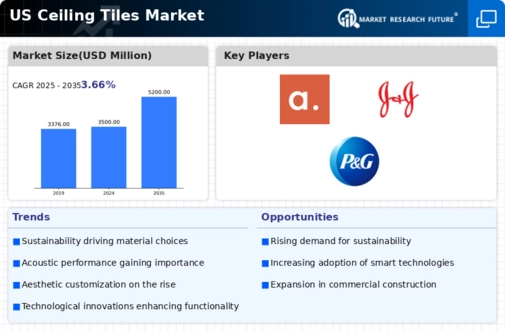Regulatory Standards and Compliance
The ceiling tiles market is increasingly influenced by regulatory standards and compliance requirements aimed at improving safety and environmental sustainability. Regulations concerning fire resistance, acoustics, and indoor air quality are becoming more stringent, compelling manufacturers to innovate and adapt their products accordingly. Compliance with these standards not only ensures safety but also enhances marketability, as consumers are more inclined to choose products that meet or exceed regulatory requirements. This trend is likely to drive growth in the market, as companies invest in research and development to create compliant and high-performance ceiling tiles that align with evolving regulations.
Rising Demand for Aesthetic Solutions
The ceiling tiles market is witnessing a surge in demand for aesthetic solutions as consumers prioritize design and visual appeal in their spaces. This trend is particularly evident in commercial sectors such as hospitality and retail, where the ambiance plays a crucial role in customer experience. Manufacturers are responding by offering a diverse range of designs, colors, and textures, catering to various architectural styles. The market's value is expected to reach $3.5 billion by 2027, reflecting a growing inclination towards customized and visually appealing ceiling solutions. This demand for aesthetics is likely to drive innovation and competition among manufacturers.
Growing Awareness of Indoor Air Quality
The ceiling tiles market is experiencing heightened awareness regarding indoor air quality (IAQ), which is influencing consumer preferences and purchasing decisions. As individuals become more conscious of the health implications associated with poor IAQ, there is a growing demand for ceiling tiles that contribute to a healthier indoor environment. Products that are low in volatile organic compounds (VOCs) and possess antimicrobial properties are particularly sought after. This trend is expected to propel the market forward, as manufacturers focus on developing ceiling tiles that not only meet aesthetic needs but also promote better air quality. The market is anticipated to expand as consumers prioritize health and wellness in their purchasing choices.
Technological Advancements in Manufacturing
The ceiling tiles market is experiencing a notable transformation due to technological advancements in manufacturing processes. Innovations such as automated production lines and advanced materials are enhancing the efficiency and quality of ceiling tiles. For instance, the integration of smart technologies allows for the production of tiles that can regulate temperature and humidity, thereby improving indoor air quality. This shift is likely to attract a broader customer base, as consumers increasingly seek products that offer both functionality and aesthetic appeal. Furthermore, the market is projected to grow at a CAGR of approximately 5.2% from 2025 to 2030, driven by these technological improvements.
Increased Investment in Commercial Construction
The ceiling tiles market is benefiting from increased investment in commercial construction projects across the United States. As urbanization continues to rise, there is a growing need for office spaces, retail outlets, and hospitality venues, all of which require effective ceiling solutions. According to recent data, the commercial construction sector is projected to grow by 4.5% annually, creating a substantial demand for ceiling tiles. This growth is likely to be fueled by the need for energy-efficient and aesthetically pleasing designs that enhance the overall environment of commercial spaces. Consequently, manufacturers are expected to capitalize on this trend by developing innovative products tailored to the needs of the commercial sector.














Leave a Comment